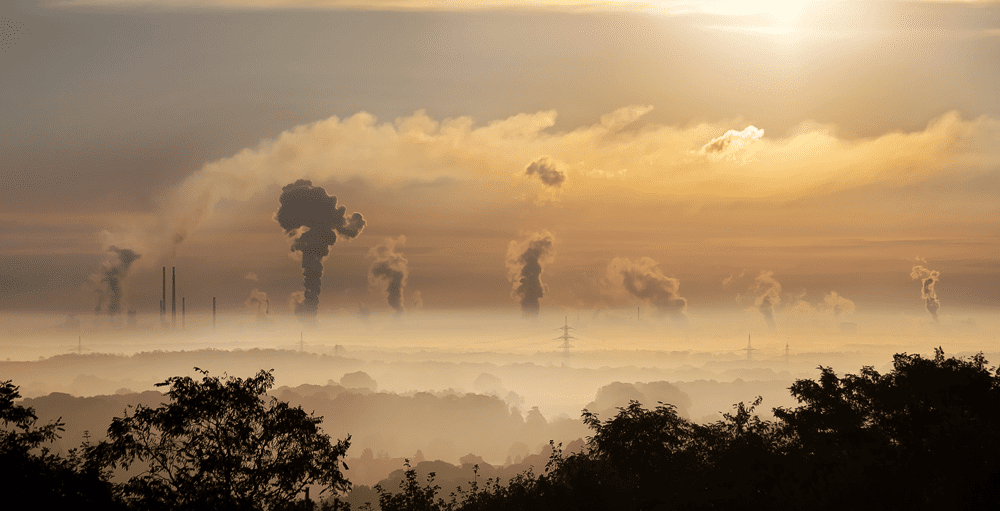Forging connections: Review of The Progress of this Storm and General Ecology
How should we understand the relationship between nature and society, now that we have entered that condition known as the Anthropocene? Two new books offer radically opposing views on this question—though, as Richard Douglas finds, both remain prisoners of post-Kantian metaphysics.
The ‘Anthropocene’ may have started out as a term of stratigraphy—coined to describe a new stage in earth’s history, in which humanity has decisively imprinted itself on earth systems the world over—but it has fast established itself as a staple of political and cultural theory. This ‘theory’ version of the Anthropocene works through the wider implications of what it means to say that humankind has decisively changed the nature of nature—and in ways that appear uncontrollable, perhaps catastrophic. Since late 2016, CUSP and the Goldsmiths Political Economy Research Centre (PERC) have been running an Anthropocene Reading Group, devoted to tackling some of the key texts emerging from this now burgeoning literature. The latest text under review, Andreas Malm’s The Progress of this Storm, stands out from many of the others. Not least, Malm explicitly attacks several of the other authors in this list, including Jedediah Purdy, Timothy Morton, Donna Harraway, Jason Moore, and (his bête noire) Bruno Latour.
Malm’s dispute with these authors centres on their endorsement of the ‘end of nature’ thesis. This has it that mankind’s technological reach has become so great that no separation can henceforth be made between society and nature. There is no natural world left, in the sense of being untouched by or exempt from the influence of man. The essence of the Anthropocene, within this thesis, is the realisation that humans have destabilised nature to such an extent that human agency will be needed to actively manage earth systems for the foreseeable future. The strongest variants of this thesis argue it was always illegitimate—an example of naïve ‘Cartesian dualism’—to suggest that nature and society could ever be separated in the first place.
Why do these arguments bother Malm so intensely? There are two elements to his criticism: the form, which comprises his intellectual objection to what he sees as a set of philosophical shortcomings verging on sophistry; and the essence, which is his disgust at the self-absorbed abstraction of those who wield such theories, given the urgent need for action in the face of climate change. He castigates postmodernist philosophers for claiming the past is a fictional text (thus robbing us of the ability to trace responsibility for present and future injustices); idealist constructionists for suggesting climate change is an idea (which thus might simply be interpreted away); new materialists for arguing that inanimate things have agency (thus obscuring human responsibility for present conditions, and potential to change them for the future); and ‘hybridists’ for suggesting that to separate nature and society is a philosophically illegitimate and deplorable example of anthropocentrism (when, on the contrary, it is only possible to discuss the relationship of two things if they remain, on some level, distinct entities). The Anthropocene does not mean the end of nature, Malm argues, but the very reverse: this is the return of nature, intruding back into our techno-society, reminding us of its independent existence—and our own dependence on it.

Malm’s overall approach is akin to grabbing the reader (specifically the academic reader) by the lapels and giving them a bloody good shake. ‘Wake up!’ he is saying. To persevere with modes of theory which often seem lost within a maze of language games is, at this time of unfolding climate emergency, not just a theoretical but a practical matter: not just self-indulgent but decadent, he seems to be saying. If theory cannot do any good, it can at least stay quiet: ‘not be a drag’, as he puts it, on the battle against ‘business as usual’ capitalism and the climate change scenarios associated with it.
Malm’s argument provides the perfect counterpoint to another recent book, General Ecology, a volume of essays edited by Erich Hörl with James Burton, whose contributions start from a very different position. Rather than focusing on society’s increasingly close relationship with nature, these works derive from currents in cultural theory which have perceived humans’ social and intellectual environments increasingly in ecological terms. Beginning perhaps in the 1960s with Marshall McLuhan’s concept of ‘media ecology’, this expansion of usage has recently gathered pace to the point at which, as Hörl puts it, there are ‘thousands of ecologies today: ecologies of sensation, perception, cognition, desire, attention, power, values, information, participation, media, the mind, relations, practices, behaviour, belonging, the social, the political—to name only a selection.’ The collective project of Hörl’s volume is to generalise this ‘ecologization of thought’, to make it an apprehensible phenomenon in its own right.
As a project, this is timely and intriguing. In execution, however, many of these essays are marred by a set of common flaws. In this respect, they offer much grist to Malm’s mill.

Probably the most illuminating case study in this collection is the chapter by Timothy Morton. A literary critic and philosopher, Morton has won academic celebrity with his writings on ecology, a feature of which is his idea of ‘hyperobjects’, things so extended in time and space as to attach themselves unavoidably to everything else. In ‘Specters of ecology’, his contribution to this volume, he develops this concern with our relationship with objects. What is now ‘required’, he tells us, is that we ‘think a radical being-with that [which] is now de-anthropocentrized.’ The goal of such thinking is to enable us to imagine ‘something like an ecocommunism, a communism of humans and nonhumans alike.’ Towards this end, Morton discusses the idea of the ‘specter’, something that ‘wavers between appearance and being.’ He argues that, following Kant, underlying reality is best understood as spectral, since we have no experiential access to things-in-themselves. Defining the ‘ecological’ as concerning the relations between things, he then argues that ecology is a study of spectres, since we never have access to these relations in themselves. This enables him to conclude: ‘To encounter an ecological entity, then, is to be haunted.’ For Morton, this is a good thing. As he puts it: ‘Ecological awareness is coexisting, in thought and practice, with the ghostly host of nonhumans.’
What is wrong with this chapter? There are the prosaic inquiries one could make, both about what Morton means and its practical relevance. In embracing the non-human he does not seem to mean simply recognizing the moral worth of other organisms (a standard green sensibility). Rather, he seems to include within his definition the entirety of an unknowable world which stands forever on the other side of a veil of consciousness. How this sensibility can intelligibly be incorporated within a political theory of communism it is hard to grasp.
To attempt a little Malm-inspired philosophical criticism here, the real problem with this chapter is its underlying intellectual heritage: that is to say, the very Kantian division Morton dwells on, between a noumenal realm of unknowable things-in-themselves and a phenomenal realm of knowable appearances. More precisely, I would like to suggest, it is what this has led to, in the sense of phenomenology—a philosophical technique which, while rich with potential, has in a kind of degenerate form come to colour a great deal of academic theory done in recent decades.
The object of phenomenology is, in the drive towards a knowledge of truth which is forever frustrated by Kantian epistemology, to find the next best thing: at least, it says, let us become certain about all we can know, the phenomenal. We must, that is, train a scientific gaze on our experience of the world in its own right. The problem with this is that it can easily distort our perception, reducing all the things of the world we experience to the single plane of our consciousness. This can be fatal for intellectual and creative writing alike, for the risk is it robs us of our discernment—chiefly of the distinction between what is us and what is not us, what is really out there and what a figment of our imagination.
The effects of this can be seen in the characteristic quality of (bad) prose poetry which afflicts much phenomenologically-inflected writing, the collapse of fictional and non-fictional genres into one. In scanning the screen of one’s consciousness one may pick out many a resemblance, however false or superficial these may really be; one association may suggest another, and a whole train of thought link together any number of things in novel and surprising ways. Within phenomenologically-inflected writing, the act of linking two things together is the link between them. Thus the grandest of theories can be built out of the mere assertion of linkages, generated by the play of consciousness over the contents of one’s own mind. (Might we, in light of all this, ask if Morton’s signature concept of the hyperobject—those entities which he cannot shake off, no matter how hard he tries—is not in every case actually himself, his consciousness of his consciousness focusing in on its own contents?)

Returning to Morton’s contribution to General Ecology, his characteristic technique is the riff. Within just the first half of this chapter, Morton links: being haunted; ‘givenness’; being ‘surprisingly surprised’; beauty; disgust; kitsch; consumerism; the idea of ennui in the poems of Baudelaire; ecological awareness; the nineteenth century ‘fascination with photographing ghosts’; and the music of Anton Webern. The effect, of course, is to draw attention to the breadth of references that populate his consciousness, and to invite delight in the exquisite arrangement he makes of them. It is writing as performance. In itself this rather gives the lie to all his brave rhetoric about embracing the non-human: his writing seems animated by a comfortingly timeless and endearingly human preoccupation with impressing other people and achieving social status.
Morton is worth dwelling on because, whatever his flaws, he offers dazzling performances as a writer, and his erudition is remarkable. But many of the other contributions to General Ecology, while not matching his virtuosity, also offer much to the reader, both in their own right and as cases that illustrate a common philosophical background. An outstanding example in this sense is James Burton’s chapter. Burton approvingly outlines a model of discourse in which ecological thinking and ‘metafictionality’ become one, merging fiction and non-fiction, reason and imagination, so that the practice of theory itself becomes ‘productive of world(s), of ever more and newer relations among things, and of ever more “things” emerging from the growth of relations.’ It is an unwittingly brilliant description of its own philosophical malady.
It would only be half-right, however, to say that this reading of General Ecology vindicates Malm’s approach in The Progress of this Storm. That is to say, it only supports Malm’s destructive arguments; his positive case must stand on its own, and this itself contains significant problems. This relates to his use both of an epistemology (a ‘realist’ version of the philosophy of mind, which enables him to argue against those who would claim climate change is just an idea), and of a political philosophy (drawing on the ideas of John Bellamy Foster and the Monthly Review school of ecological Marxism). In both cases, it appears he is, as it were, trying on borrowed clothes which do not quite fit; that these are ideas he is grabbing for, out of the need to find at hand some alternative structure of ideas that would do, to support his core concern—namely anxiety at the environmentally suicidal tendencies of contemporary society, and the need to force a change in direction.

Regarding epistemology, his chief interest is in furnishing himself with a philosophical foundation for attacking the argument that reality is a subjective construction. But at the same time he is keen to avoid the charge of crude physicalism, which has it that only the material is real, and that all ideas can be reduced to physical processes in the brain. He finds what he is looking for in a philosophy of mind based on a metaphysics in which the material world, including human brains, is all that exists; but in which each material thing has certain properties, which in the case of brains include thoughts. As even he himself concedes at one point, this resolves nothing, since it leaves the question begging: what on earth are properties if they don’t exist—and if they don’t exist, how can they interact with things that do? What he is left with is in fact a nineteenth century materialist metaphysics, in which, as he asserts, the only real things in existence are those comprised of the same property-less substance, ‘made up of atoms and other particles’. It is simply that this materialism is patched over with an incoherent assertion that this does not, actually, fully describe reality at all.
This epistemology is still quite incidental to his thought, however. More problematic, because more central, is his political philosophy. What links them both is the the same warmed-over materialism. In the case of his politics this is done explicitly with his naming of Marxist historical materialism as the philosophy to which he pledges allegiance. Here, too, there are attempts to update the original which only result in an unconvincing mish-mash. Crucially, the Marxism which emerges from these pages is one in which all sense of historical determinism has been consigned to the dustbin of intellectual history. Ideas are not deterministic products of material relations (since they are not material substances themselves), and nor is economic and social development determined by the self-defeating exploitation of labour (since natural resources are also acknowledged to contribute to economic value). But for all this, the form of historical materialism is retained, something reflected most prominently in the analysis of capitalism as a dynamic in history which is wholly external to ‘us’.

It is in discussing capitalism that Malm himself adopts a crude form of society vs nature dualism: when he talks about capitalism as a uniquely unsustainable and wicked form of society, that is, in contrast to the society-in-harmony-with-nature which obtained before capitalism (and presumably could obtain again, if capitalism might be overthrown). Malm consistently telescopes the entirety of the industrial epoch of history, from the birth of the industrial revolution right through to a future catastrophic ending it is projected to result in, and reads it all as a single passage to disaster. It is here that the unconvincing nature of this updated form of Marxism makes itself most acutely felt—for this is a Marxism stripped of the illusion of any inevitability in the revolutionary overthrow of capitalism, much less of a communism of abundance that might succeed it. All that is left is a narrative of moral binaries, tempting him into declaring his support for ‘ecological class hatred, perhaps the emotion most dearly needed in a warming world’. Hatred for the rich and pity for the poor: this is all he offers. Of a compelling positive vision, or even the first idea how to win over the millions of people who vote for climate change deniers, there is little sign.
If we were to seek to move beyond both the materialism and idealism (in the forms both of phenomenology and constructionism) on display in these works, how differently might a review of the relationship between nature and society prompt us to think? Let me, in concluding, sketch an alternative approach in brief.

In its original form, ‘ecology’ refers to the relationships of organisms with their biotic environments. What this idea suggests is that the natural world is replete with dynamic systems which have the potential to generate order as an emergent property. If ‘thinking ecologically’ is to recognize human embeddedness within a natural environment, our dependency upon and fragility in relation to it, then what it should do is lead us out of ourselves, towards an inquiry into the nature of nature and its capacity to generate order. Malm is clearly driving in this direction, since when not derailed by defunct forms of materialism he lays great stress on contemporary literatures which discuss how order—indeed, whole levels of reality—may be generated as an emergent property by the relationships between existents. But where one might go further is in seeing that this generation of order, this structuring of existence into tiers of reality, can only be understood, not as a thing, but as a principle, a grammar of existence. It exists but is not material, hence cannot figure within a wholly materialist metaphysics.
To think of an encounter with the non-human as being necessarily macabre meanwhile, as Morton does, a matter of being haunted by uncanny spectres, is to retain a thoroughly anthropocentric view of nature, in which human consciousness is the sole creator of order in existence: to stare into the non-human therefore is indeed to look into a nightmarish void. To really ‘think a being-with’ the non-human—the totality of existence which predates us, and will go on after we are gone—must be to recognize existence-as-a-whole as an environment for all that exists. One, moreover, which is intelligible to human reason and in whose nature we share. An older name for this would be creation.
